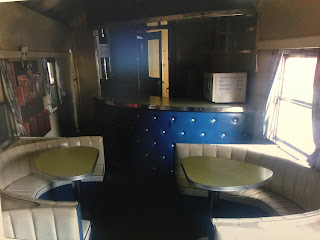One day I caught the local bus from my Dad's place in the Bunbury suburbs to the city centre, to see what had changed since I visited it as a a kid.
In my primary school years I lived in a little locality called Argyle, halfway between the country towns of Donnybrook and Boyanup. From our orchard it was about 30km to Bunbury, the big regional centre and in those days a city of about 25,000 people.
My impression in the 1970s was that Bunbury was very dull. An industrial port city, it seemed little interested in its history; certainly compared with the similarly-sized south coast town of Albany, which placed great emphasis on its heritage (having been founded before Perth).
By my childhood years, all Bunbury's cinemas had closed down, a victim (I assume) of the rise of television. There were, however, two drive-in cinemas which we sometimes visited for night-time entertainment.
Bunbury is still not a major tourist destination. Its one big attraction is the Dolphin Discovery Centre on Koombana Bay, where dolphins regularly interact with humans. Other than that, there are some good beaches in and around the city.
Food and drink has improved a lot, however, since I was a kid. Back then, our dining-out choices were pub food, basic Chinese, basic Italian or (excitement!) the newly opened KFC. Now there's a broad array of cuisines on offer.
Bunbury has also finally embraced its history. A few weeks before I visited, the Bunbury Museum & Heritage Centre opened within the central Paisley Centre, a former school built in 1886.
I stepped in to have a look. The museum's interior is pleasant and spacious, its exhibits spread through a number of rooms with polished timber floors. There's even a sense of humour in the "museum rules" sign at the entrance:
In the first room I was fascinated to discover that Bunbury's location had been visited by the 1800-1803 expedition of Nicolas Baudin, a French explorer who'd been commissioned by Napoleon to visit Australia. This was several decades before the city was founded in 1836.
I knew about Baudin via a 2012 exhibition at Melbourne's NGV which had focused on Baudin's claim to parts of Victoria and South Australia, named by him as Terre Napoléon.
Before he reached the east, however, he spent time in the west, and several places still bear the names he gave them; for example, the great bay that sweeps southwest past Busselton is called Geographe Bay after one of his ships, and Point Naturaliste is named after another. The Leschenault Estuary north of Bunbury was named for one of Baudin's botanists.
In tribute, the Bunbury museum has an excellent detailed model of the Geographe:
In addition to exhibits about the local Aboriginal culture and history of the area, which the Noongar people have lived in for some 45,000 years, there are displays focused on specific elements from more recent history.
It's somewhat disconcerting when you encounter items from your own lifetime in a history museum, but this was so as I saw photos of the old Australind train which ran between Bunbury and Perth during my childhood (this was the buffet car)...
... and an exhibit on the Mayfair Drive-in, where we used to see movies under the stars:
They even have the old Mayfair projector in place, a huge piece of equipment from the pre-digital age:
After this heady dose of local history mixed with personal remembrance, I pursued a further piece of intensely personal history. The museum is located close to the original location of the now-relocated St John of God Hospital, where I was born. After a quick enquiry at a nearby real estate agency, I found the vacant lot:
The Bunbury Museum & Heritage Centre is located at 1 Arthur St, Bunbury, Australia. Free entry, open 10am-4pm Tuesday to Sunday. For more details visit its website.







No comments:
Post a Comment